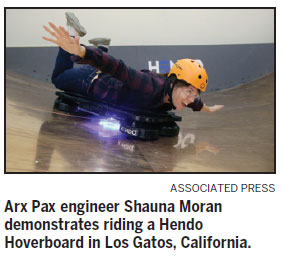We have liftoff: 'Hoverboard' takes flight
Updated: 2014-11-21 07:28
By Agence France-Presse in Los Gatos, United States(China Daily USA)
|
|||||||||
Ever since Marty McFly rode on one in 1989's hit film Back to the Future Part II, fans have dreamed of having their own levitating skateboard, or "hoverboard".
That wish has now come true, as engineers in California have turned the futuristic device into reality.
The Hendo Hoverboard levitates on conductive surfaces. Defying gravity, it floats about an inch above the ground, powered by four disc-shaped magnetic engines.
That means you can ride it just like a skateboard on a ramp-style platform, albeit one made only of metal or otherwise electricity-conducting material, to produce the magnetic field.
It can move speedily, if noisily, in multiple directions, as well as turn around. The battery only lasts seven minutes, but that is still enough time to take a grown adult for an exhilarating ride.
The technology that propels it is called magnetic field architecture and was developed by the startup company Arx Pax, which turned to the Kickstarter crowdfunding website to raise so-called seed money to bring it to market.
"We want to seed this hover ecosystem by putting the technology into the hands of all those tinkerers," says Jill Avery Henderson, co-founder and chief operating officer of Arx Pax.

The board itself - which is partly made by a 3-D printer - levitates on top of conductive materials such as aluminum or a copper half-pipe, which its makers have been using to show off their device.
Arx Pax chief executive Greg Henderson, who founded the company with his wife, explains the technology behind it.
"We are creating a magnetic field, and then through a method of induction - that's part of our secret sauce - we are creating a secondary and equal magnetic field in this conductive surface," he says.
And the couple believe their technology could be used for all sorts of purposes, even for example designing more earthquake-resistant buildings - a particular concern in quake-prone California.
In theory, with more powerful magnets, an entire building could be made to float off the ground, albeit briefly.
"Imagine there's an earthquake and the early warning turns on the warning systems and the (concrete or other physical) supports fall away as the building starts to hover," says Henderson. "The shaking stops, the supports return, and no one in that room or in that building ever knew there was an earthquake."
The pioneering pair long ago reached their target of $250,000 on Kickstarter, and the first 10 "hoverboards" - costing $10,000 apiece - have sold out in advance.

 Chocolate warriors with Christmassy characteristics
Chocolate warriors with Christmassy characteristics
 Trending: Panda beating video triggers outrage
Trending: Panda beating video triggers outrage
 Culture Insider: 7 things you may not know about Minor Snow
Culture Insider: 7 things you may not know about Minor Snow
 Practitioners adapt old operas to fit modern lifestyles, tastes
Practitioners adapt old operas to fit modern lifestyles, tastes
 The future of the Asian Pacific
The future of the Asian Pacific
 Early start to family life
Early start to family life
 Chinese lantern festival is coming to California
Chinese lantern festival is coming to California
 Across America over the week (Nov 14- Nov 20)
Across America over the week (Nov 14- Nov 20)
Most Viewed
Editor's Picks

|

|

|

|

|

|
Today's Top News
China's interest rates cut to bolster growth
Strong earthquake hits SW China
Banner year for US, NYC real estate investment: Panel
Obama takes executive action on immigration
China's central bank cuts interest rates
Chinese lantern festival is coming to California
Cookstove technology key in fighting pollution
Chinese supercomputer still top-ranked
US Weekly

|

|








